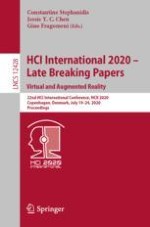This book constitutes late breaking papers from the 22nd International Conference on Human-Computer Interaction, HCII 2020, which was held in July 2020. The conference was planned to take place in Copenhagen, Denmark, but had to change to a virtual conference mode due to the COVID-19 pandemic.
From a total of 6326 submissions, a total of 1439 papers and 238 posters have been accepted for publication in the HCII 2020 proceedings before the conference took place. In addition, a total of 333 papers and 144 posters are included in the volumes of the proceedings published after the conference as “Late Breaking Work” (papers and posters). These contributions address the latest research and development efforts in the field and highlight the human aspects of design and use of computing systems.
The 34 late breaking papers presented in this volume were organized in two topical sections named: Virtual, Augmented and Mixed Reality Design and Implementation; and User Experience in Virtual, Augmented and Mixed Reality.
